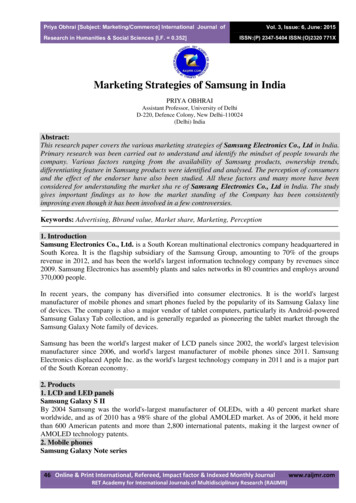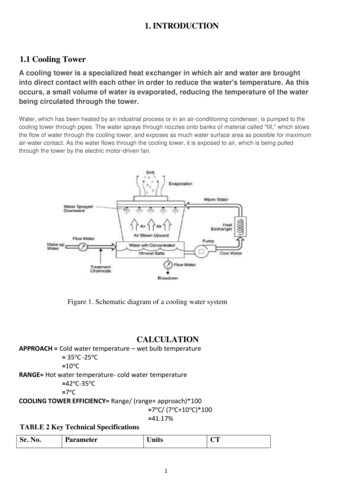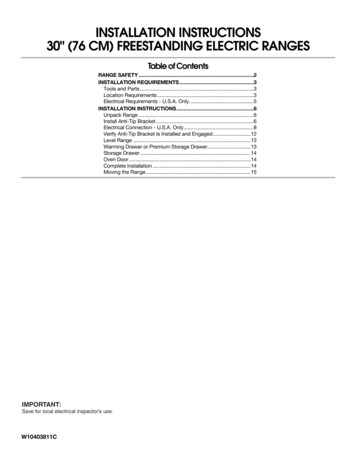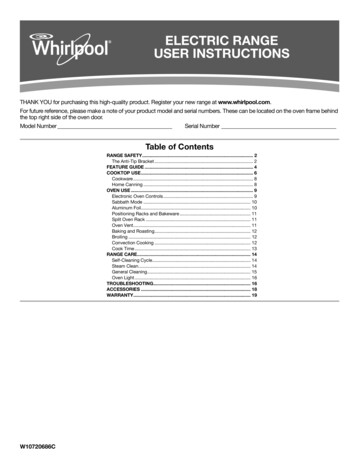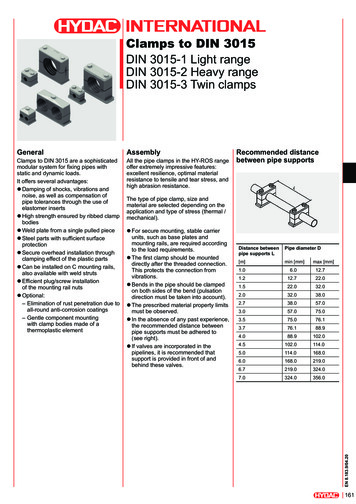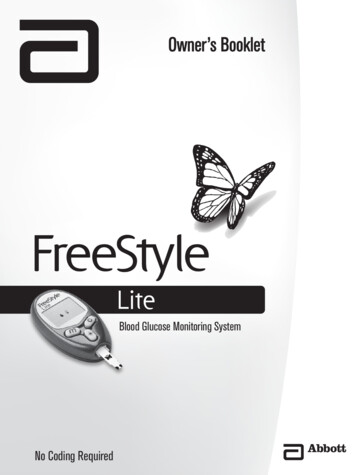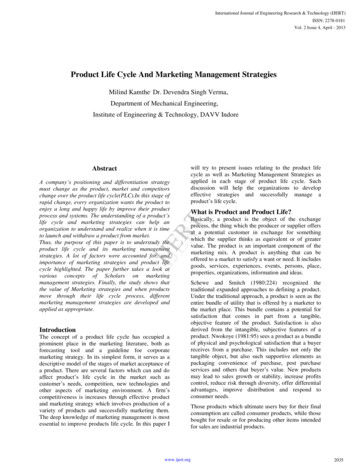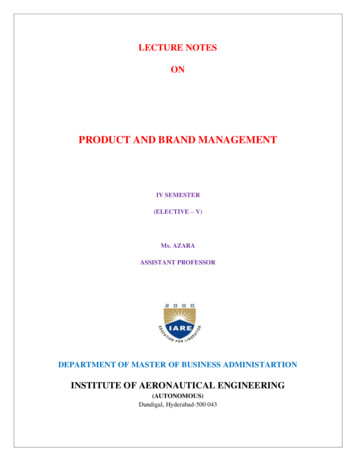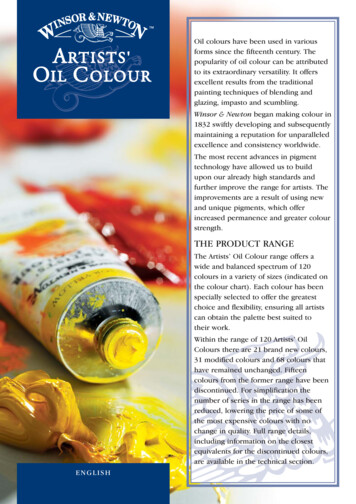
Transcription
Oil colours have been used in variousforms since the fifteenth century. Thepopularity of oil colour can be attributedto its extraordinary versatility. It offersexcellent results from the traditionalpainting techniques of blending andglazing, impasto and scumbling.Winsor & Newton began making colour in1832 swiftly developing and subsequentlymaintaining a reputation for unparalleledexcellence and consistency worldwide.The most recent advances in pigmenttechnology have allowed us to buildupon our already high standards andfurther improve the range for artists. Theimprovements are a result of using newand unique pigments, which offerincreased permanence and greater colourstrength.THE PRODUCT RANGEThe Artists’ Oil Colour range offers awide and balanced spectrum of 120colours in a variety of sizes (indicated onthe colour chart). Each colour has beenspecially selected to offer the greatestchoice and flexibility, ensuring all artistscan obtain the palette best suited totheir work.Within the range of 120 Artists’ OilColours there are 21 brand new colours,31 modified colours and 68 colours thathave remained unchanged. Fifteencolours from the former range have beendiscontinued. For simplification thenumber of series in the range has beenreduced, lowering the price of some ofthe most expensive colours with nochange in quality. Full range details,including information on the closestequivalents for the discontinued colours,are available in the technical section.ENGLISH
Characteristics of the Artists’ Oil Colour RangeArtists’ Oil Colour uses the highest level ofpigmentation consistent with the broadesthandling properties. The individualcharacteristics of each pigment aremaintained allowing individualcharacteristics to be explored by artists.Pigment strength provides covering powerand tinting strength, leading to the saying“artists’ quality goes further”.Covering PowerCovering Power not only comes frompigment strength, but also from thegreater thickness of colour, whichresults from the stiff consistencyassociated with Artists’ Oil Colour.Covering power is particularly linked tothe most opaque colours like TitaniumWhite and the Cadmiums.Pigment PurityLike all raw materials, pigments areavailable in various grades. We useonly the purest of pigments ensuringthe cleanest, brightest colours, whichproduce the best colour mixtures.Widest SpectrumWe are famous for providing the widest spectrum ofcolours within our ranges. The colours are selectedaccording to mass tone [colour from tube],undertone [bias of colour when in a thin film],strength and relative opacity. This provides thelargest number of colour positions and an infinitenumber of colour mixtures. A total of 100 differentpigments are used to produce 120 colours.Use of single pigmentsVariable OpacityArtists’ Oil Colour is formulated to reflectthe characteristics of each of the variouspigments, ensuring that synthetic organicssuch as Phthalocyanines andQuinacridones [ie. “Winsor”or “Permanent colours”] deliver maximumtransparency, whilst Cadmiums and Earthcolours offer excellent opacity.Winsor & Newton were the first company topublish the contents of their colours in 1892,believing in providing artists with as muchinformation as possible.Today the pigments used in Artists’ Oil Colourare printed on the labels, in our literature and onour website, www.winsornewton.com.Clear Label InformationShort Buttery ConsistencyThe buttery consistency of Artists’ OilColour, together with the smell oflinseed oil, are the two characteristicsmost admired by oil painters. Thesequalities are unbeaten by other media.The stiff consistency of Winsor &Newton colours can retain brush orpalette knife marks or it can be thinnedto the very finest of glazes.Vehicle usedOpacity rating1214094Our quality standards include the use of singlepigments wherever possible to create individualcolours. Combined with strength of colour, singlepigments provide a wide colour range in themselvesand offer cleaner, brighter mixtures with an infiniterange of hues. This is particularly important forgreens, violets and oranges. Single pigment‘secondaries’ considerably broaden the artists’available spectrum. There are 80 singlepigment colours in the range.1CADMIUM REDCADMIUM REDLightfastness ISolidité à lalumière IHuile extra-fineKünstler - ÖlfarbenColores al Oleo para ArtistasColori ad Olio per ArtistiPigment :Sulphosélènieure decadmium, PR108Liant : Huiles de lin etde carthame raffinéeROUGE DE CADMIUMDrying RatesThe long drying time of Artists’ OilColour is also a key feature of oilpainting. The colour remains soft andwet for a few days and thereforeallows corrections to be made from day to day.All colours will become touch dry in thin films in2-12 days. The different reaction of each pigmentwhen mixed with oil results in the different dryingrates. Each colour is individually formulated tooptimise its drying rate, which helps artists to avoidthe problems of slow drying underlayers. However,the following list is a guide to the likely variations:Fast Drying [around two days]:Permanent Mauve [manganese], Cobalt Blues,Prussian Blue, Raw Sienna, Umbers, Flake,Foundation and Cremnitz Whites [lead].Pigment ContentColour NameProduct CodeB32094Pigment StrengthPublished Pigment InformationPigment: Cadmiumsulphoselenide, PR108Vehicle: Linseed/safflower oilsKADMIUMROTROJO CADMIOROSSO DI CADMIO094PERMANENCE ASERIES 437mlASTM ratingColour Code1.25 U.S. fl.oz.Made in EnglandWinsor & Newton, LondonHA3 5RHwww.winsornewton.comSeries NumberPermanence ratingMedium drying [around five days]:Winsor Blues and Greens [phthalocyanines],Burnt Sienna, Cobalt Violet and Greens, UltramarineBlues, Mars colours [synthetic iron oxides], SapGreen, Permanent Alizarin Crimson, Ochres,Cadmiums, Titanium White, Zinc White, LampBlack, Ivory Black, Pyrrols, Bismuth Yellow,Perylenes.Slow drying [more than five days]:Winsor Yellows (arylides) and Orange,Quinacridones, Alizarin Crimson.Winsor & Newton Liquin is the perfect medium tospeed the drying time of oil colour. It will speeddrying by approximately 50%.
FormulationPermanenceEvery Artists’ Oil Colour is individually formulated toenhance each pigment’s natural characteristics andensure the stability of individual colours.Combined with over 170 years of manufacturing andquality control expertise, the formulation of Artists’Oil Colour ensures thebest raw materials aremade into the World’sFinest Colours.Since 1832 we have been developing permanentalternatives for the less durable traditional colours,without compromising the handling properties of theoil colours. As a result, the permanence of thecolour range as a whole has been improved beyondthe dreams of past painters.Of the 120 colours in the range, 119 are nowclassed as ‘permanent for artists’ use’ [AA or Aratings from Winsor & Newton] which aids in thelongevity of paintings. Although Alizarin Crimson isonly given a “B” rating (moderately durable), it hasbeen part of Artists’ Oil Colour for over 130 yearsand is still considered a key colour by manycontemporary artists. For a more detailedexplanation of permanence and the individual ratingof each colour see the Technical Section or visitour website atwww.winsornewton.com.Consistent QualityWinsor & Newton are trusted bymore artists than any otherbrand worldwide. This is aresult of the quality andpermanence of Artists’ OilColour and from the reliabilityof our production supply.Whether its hue, opacity or drying time the artistseeks, they can be sure to get the same producttime and time again.Mixing ColoursThe three primary colours in the Artists’ Oil Colourrange are Transparent Yellow, Winsor Blue [RedShade] and Permanent Rose. These colours are thebest selection when only three colours are used. Werecommend Winsor Lemon, Winsor Yellow, FrenchUltramarine, Winsor Blue [Green Shade], PermanentRose and Cadmium Red when using a six colourmixing system.Whites in the rangeSince white is the most commonly used colour, appropriate selection is vital.Artists’ Oil Colour offers the widest choice of oil colour whites.Safflower Oil WhitesTitanium White; The most popular modern white.It is the whitest, and the most opaque. Where itsstrength is overpowering, alternative whitescan be used.Flake White No. 1; The traditional lead white thatis excellent as a result of its flexibility, durabilityand speed of drying. The inclusion of zinc pigmentimproves its consistency. It iswarmer than Titanium White andfirmer in consistency.Zinc White; The least opaquetraditional white making it ideal fortints and glazing. It has a blueundertone.Cremnitz White; also made fromlead. The absence of zinc gives along extended mark and a stringyconsistency. The perfect alternativefor artists who prefer a pure leadcolour, similar to that used by the“Old Masters”. It is fast drying.Iridescent White; A mica basedpigment which makes a pearlescentwhite. It is effective when mixed withtransparent colours, and used overdark underpainting.Transparent White; A new uniquetitanium based colour. Greatlyweaker and more transparent thanZinc White. Ideal for tonal mixturesand glazes and for those wishing toavoid opacity and covering. Amedium drier, it will produce thevery strongest tints.Linseed Oil Whites:Flake White Hue; A titanium based formulationwhich avoids the hazardous lead based Flake WhiteNo. 1. It has a lower tinting strength than TitaniumWhite to match Flake White and a similar drying rateto the original.Note: Safflower whites are not recommended forextensive underpainting or priming. The slow dryingnature of the oil may cause subsequent layers tocrack. Linseed oil whites are recommended.2Underpainting White (fast drying); A titaniumpigment ground in linseed oil which isrecommended for underpainting or extensivelayering with white. It dries quickly to a flat,matt, toothy finish.Foundation White; A lead pigment ground inlinseed oil which is recommended for primingor extensive layering with a lead white.Both linseed oil whites can be used throughoutthe painting if desired.Please refer to the technical section of our websitefor more comprehensive details on our whites andthe other main colour groups.
Oil Colour AccessoriesSurfaces and PrimersOils and MediumsStretched, primed canvas is the traditional supportfor oil colour. Canvas boards are also popular. OurWinsor Canvas, Winsor Linen or Winsor Board (notavailable in the USA) are recommended for the artistwanting to exploit a variety of techniques and ensurelong term stability. Paper can also be used,provided it is sized and primed correctly.Heavyweight Winsor & Newton Water Colour Paperprimed thinly with Acrylic Gesso Primer is ideal.Oils and mediums alter the handling characteristicsof the colour and help to maintain the flexibility ofthe finished painting (fat over lean) Oils are thetraditional, slower drying choice whilst alkyd basedmediums, such as Liquin, are favoured due to theirspeeding the drying time of the painting.SolventsSolvents are used to dilute colours and to cleanbrushes and equipment. English Distilled Turpentinemakes a viscous mixture which evaporates slowly.It is the most hazardous and strongest smellingsolvent, and can deteriorate on storage. Artists’White [or mineral] Spirit (not available in the USA)makes a watery mixture which evaporates quicklyand is less hazardous. It does not deteriorate onstorage. Sansodor makes a viscous mixture,which evaporates slowly, and is the least hazardous.It does not deteriorate on storage, has a minimalodour and can betravelled withsafely.VarnishesVarnishes are used to protect finishedpaintings. For fine art usage, picturevarnishes should be removable sothat the painting can be cleanedin the future. Our varnishesare labelled “gloss” or“matt” and vary accordingto the different resins used.BrushesTo thickly apply colour orimpasto, bristle brushes are mostcommon. Winsor & Newton have threeranges, Artists’ Hog [Rathbone in USA], Winton and Azanta . The stiff nature of the bristle and itsnatural split tips, (called ‘flags’), result in brusheswhich wear well and carry considerable quantities ofcolour. To blend and glaze, a soft hairbrush isrecommended such as Cirrus sables orSceptre Gold II which are a blend ofnatural and synthetic fibres.PalettesMahogany palettes are the traditional palette for oilcolour. However, because canvases are primarilywhite, white melamine palettes are often preferredby modern painters together with expendable paperpalettes which can be disposed of at the end ofeach painting session.3For more information on all of our ranges includingoils, mediums, varnishes and accessoriesplease see our catalogue or website atwww.winsornewton.com
New, Modified and Discontinued ColoursNew coloursCol. Code New ColoursReason for new colourBenefit025056059183191242294320Bismuth YellowBrown MadderBrown OchreCobalt Chromite GreenCobalt Turquoise LightFlake White HueGreen GoldIndian Yellow DeepNew colour to improve the spectrum across the range.Replaces the former Brown Madder Alizarin.New colour to improve the spectrum across the range.Replaces the unavailable Cobalt Green Deep.New colour to improve the spectrum across the range.New colour to improve the spectrum across the range.New colour to improve the spectrum across the range.New colour to improve the spectrum across the range.425479505543545548558557648657Naples Yellow DeepPermanent CarminePerylene BlackPurple MadderQuinacridone MagentaQuinacridone RedRaw Umber (green shade)Raw Umber LightTransparent Brown OxideTransparent MaroonNew colour to improve the spectrum across the range.Lightfast/permanent replacement for Carmine.New colour to improve the spectrum across the range.Replaces the former Purple Madder Alizarin.New colour to improve the spectrum across the range.New colour to improve the spectrum across the range.New colour to improve the spectrum across the range.New colour to improve the spectrum across the range.New colour to improve the spectrum across the range.New colour to improve the spectrum across the range.647655745Transparent Red OchreTransparent WhiteYellow Ochre LightNew colour to improve the spectrum across the range.New colour to improve the spectrum across the range.New colour to improve the spectrum across the range.Semi-opaque permanent yellow which also gives bright colour mixing.No change.An orange-brown natural earth, close to our previous Brown Ochre. Makes more natural mixtures.A stronger, slightly bluer, more opaque colour.Bright turquoise, good sky and decorative colour.A warm white alternative to genuine lead whites.Bright yellow shade green - a strong useful mixing colour.Highly transparent, single pigment providing wider mixing capabilityGood replacement for traditional lakes.Single pigment providing wider mixing capability. An excellent tonal mixing colour.Significant improvement in permanence. A lightfast colour for floral painters. Lower in cost.A unique green undertone, excellent for mixing and glazing.No change.Strong, bright permanent magenta excellent for floral painters.Strong, bright, transparent, permanent red excellent for floral painters. Makes clean mixtures.A green shade natural umber.A pale, natural umber which makes more natural strength mixtures.Single pigment good for glazing with excellent red undertone.Dense, highly transparent, strong, single pigment maroon for wider colour mixing capability.Excellent for darks and shadows. Unique.The most transparent orange-red ochre on earth. Good for glazing, and natural strength mixtures. Unique.A glazing and mixing white, which reduces the strength of colours without chalky effect.A pale natural earth, which makes more natural strength mixtures.Modified coloursCol. Code Modified ColoursReasons for ModificationChange in oved lightfastness/permanence.Increased colour strength offering a greater tinting ability and improved covering power.Increased colour strength offering a greater tinting ability and improved covering power.Increased colour strength offering a greater tinting ability and improved covering power.Increased colour strength offering a greater tinting ability and improved covering power.Increased colour strength offering a greater tinting ability and improved covering power.Increased colour strength offering a greater tinting ability and improved covering power.Increased colour strength offering a greater tinting ability and improved covering power.Colour adjusted to improve spectrum across the range.Colour adjusted to improve spectrum across the range.Improved lightfastness/permanence.Increased colour strength offering a greater tinting ability and improved covering power.Improved lightfastness/permanence.New formulation due to discontinued pigment.Increased colour strength offering a greater tinting ability and improved covering power.Improved lightfastness/permanence.Improved lightfastness/permanence.Improved lightfastness/permanence.Increased colour strength offering a greater tinting ability and improved covering power.Increased colour strength offering a greater tinting ability and improved covering power.New formulation due to discontinued pigment.New formulation due to discontinued pigment.Colour adjusted to improve spectrum across the range. New single pigment.New formulation due to discontinued pigment. Improved lightfastness/permanence.Colour adjusted to improve spectrum across the range.Increased colour strength offering a greater tinting ability and improved covering power.Improved lightfastness/permanence.Colour adjusted to improve spectrum across the range. Improved lightfastness/permanence.Increased colour strength offering a greater tinting ability and improved covering power.Increased colour strength offering a greater tinting ability and improved covering power.Increased colour strength offering a greater tinting ability and improved covering power.Slightly yellower.No change.No change.No change.No change.No change.No change.No change.Brighter.Slightly cleaner and brighter.No change.No change.No change.No change.No change.No change.No change.No change.No change.No change.No change.No change.Very slightly redder.No change.Slightly yellower.No change.New single pigment. Redder undertone.Slightly bluer.No change.No change.Very slightly greener.Bright RedCadmium LemonCadmium OrangeCadmium RedCadmium Red DeepCadmium ScarletCadmium Yellow DeepCadmium Yellow PaleCopperGold OchreJaune Brillant (not USA)Mars BlackNaples Yellow LightOlive GreenOxide of ChromiumPermanent GreenPermanent Green DeepPermanent Green LightPermanent RosePhthalo TurquoisePrussian GreenPurple LakeRaw UmberSap GreenScarlet LakeWinsor LemonWinsor OrangeWinsor RedWinsor VioletWinsor YellowWinsor Yellow DeepDiscontinued coloursCol. Code Colour NameReason for DiscontinuationNearest Equivalent in Replaced by more lightfast, transparent stronger pigment.Alizarin pigment no longer used.Can be mixed by the artist .Replaced by lightfast pigment.Pigment now unavailable.Can be mixed by the artist.Can be mixed by the artist.Can be mixed by the artist.Close to Terra Rosa.Close to Indian Red.Very close to Gold Ochre.Replaced by a cheaper, more lightfast formulation.Alizarin pigment no longer used.Can be mixed by the artist.Can be mixed by the artist.Indian Yellow DeepBrown MadderCadmium Lemon ViridianPermanent CarmineCobalt Chromite GreenCobalt Violet Winsor VioletFlake White No. 1. Linseed OilGold Ochre Venetian Red Mars BlackTerra RosaIndian RedGold OchreSap GreenPurple MadderRose Madder Genuine Alizarin CrimsonCadmium Red Cadmium Red Deep Titanium WhiteAureolinBrown Madder AlizarinCadmium GreenCarmineCobalt Green DeepCobalt Violet DarkFlake White No. 2Mars BrownMars OrangeMars VioletMars YellowPermanent Sap GreenPurple Madder AlizarinRose Madder DeepVermilion Hue4
Technical SectionThe Technical Section contains three areas:1. Composition and Permanence Table.2. New, Modified and Discontinued colours.3. Colour Chart (please see reverse of leaflet).Composition and Permanence TableColour Code – CodeThis is the colour name, eg. Permanent AlizarinCrimson.oil colour. In this system I is the highest lightfastnessavailable although both ratings I and II are consideredpermanent for artists’ use. Where no ASTM rating isgiven for our colour, this indicates that the pigmenthas not yet been tested by the ASTM. It does notindicate a lack of lightfastness. In these cases it isrecommended that the Winsor & Newton permanencerating, which is the rating system evaluating colouron many aspects including lightfastness, should beused to indicate a colour’s ability to resist fading.SeriesTransparency/Opacity - T/OThe series number of a colour indicates the relativeprice of the colour and is determined primarily by thecost of the pigment. Series 1 is the least expensive,Series 5 the most expensive.The transparent colours are marked ( ), the semitransparent colours are marked ( ), the opaquecolours are marked as ( ) and semi-opaque coloursare marked ( ). Transparency however is relative andthe ratings are provided as a guide only. Also, anythin film of colour will appear more transparent than athicker one.The colour code indicates the code number that isgiven to each of the colours. This is primarily for easeof reference ,catalogue purposes and to assist youwhen purchasing your materials.Colour namePermanenceThe permanence of an oil colour is defined as ‘itsdurability when laid with a brush and palette knife onordinary prepared canvas, graded appropriately anddisplayed under a glass frame in a dry room, freelyexposed to ordinary daylight and an ordinary townatmosphere’. This definition reflects the manner inwhich the majority of paintings are displayed.However, for testing purposes we are able to utiliseaccelerated tests for lightfastness and binder stabilityin addition to the information issued by our pigmentsuppliers. Our ratings are therefore a combination ofthe natural passage of time, accelerated tests andpigment manufacturers’ testing and development.They are among the most stringent in the industry.AA - Extremely permanentA - PermanentB - Moderately Durable(iii) Bleached by acids, acidic atmospheresASTMThe ASTM abbreviation stands for the AmericanSociety for Testing & Materials. This organisation hasset standards for the performance of art materialsincluding the lightfastness of colour.To measure lightfastness using this system, coloursare reduced to a level of 40% reflectance by theaddition of Titanium White. The reflectance is definedas the amount of light reflected from the colourswatch. The swatches are then tested in both sunlightand artificially accelerated conditions. The resultsallow each colour to be rated on a scale from I-II forChemical descriptionThis provides the chemical description of thepigments used in each colour. This is oftenparticularly useful for conservators.Colour IndexThe Colour Index International is the standardcompiled and published by both: The Society ofDyers and Colourists, and the American Associationof Textile Chemists and Colorists.The Colour Index classifies pigments by theirchemical composition.This information allows you to research a specificpigment’s working characteristics in reference booksif you wish or to make product comparisons. Theindividual pigments are identified in two ways.a] Colour Index Generic Name - C.I. NameEach pigment can be universally identified by itsColour Index Generic Name.As an example: Cobalt Blue is Pigment Blue 28,abbreviated to PB28.Although the working properties of our colours arefully detailed in our literature, we publish the ColourIndex Generic Names of the pigments to allow you tocross reference the working properties in othersources if you wish e.g. lightfastness, opacity,toxicity, etc. The Colour Index Generic Name isparticularly necessary to identify some of the modernpigments such as Arylide Yellow which has a numberof different types, each offering different levels oflightfastness and opacity.5b] Colour Index Number - C.I. No.Pigments can also be identified by their Colour IndexNumber. It is considered an additional source ofidentification to the Colour Index Generic Name. Forexample: Cobalt Blue is 77346.Of the two methods of reference, the Colour IndexGeneric Name is most commonly used.Health & Safety ConsiderationsArtists’ colours are chemical preparations and ourproducts should be used and handled correctly. Welabel according to current legislation in themarketplace in which they are being sold.Treated with care, they should not present any serioushazards to health, but prolonged contact with the skinand ingestion (swallowing) of the product should beavoided. This includes such practices as applyingcolour with fingers and placing brushes in the mouthto point them. Please read the product labels carefullyand should any further information be required pleasesee our catalogue, the Health & Safety productinformation leaflet or visit the Health and Safetysection on our website at www.winsornewton.com.
C OLOUR R ANGE347 AA S4I *LemonYellow Hue722 A S2II *Winsor Lemon726 A S2094 A S4I * Cadmium Red*Winsor Red086 A S4I * CadmiumLemon025 A S4653 A S4BismuthYellowTransparentYellow042 A S1*725 A S2IWinsorRed Deep543 A S2Bright Red380 A S2I *Magenta545 A S2IQuinacridoneMagenta544 A S1184 AA S5I *Cobalt Green084 A S4I *CadmiumGreen Pale708 A S2I *WinsorEmerald422 A S1425 AA S2426 A S1I *Naples YellowLight395 AA S2I *Mars VioletDeep*Purple LakeNaples YellowNaples YellowDeep056 A S1I *Brown Madder076 AA S1I * Burnt Umber730 A S2I *Winsor Yellow149 A S1I *ChromeYellow Hue118 A S4I *CadmiumYellow Pale320 A S2IIndian YellowDeep319 A S2I *Indian Yellow108 A S4I * CadmiumYellow731 A S2IWinsorYellow Deep111 A S4ICadmiumYellow Deep089 A S4I *CadmiumOrange724 A S2Winsor Orange257 A S2I *Flesh Tint106 A S4I *CadmiumScarlet603 A S2*097 A S4I *CadmiumRed Deep548 A S4502 A S2I *PermanentRose576 A S5IIRose Doré587 A S5IIRose MadderGenuine004 B S2468 A S4I * PermanentAlizarinCrimson479 A S2QuinacridoneRed192 AA S5I *Cobalt Violet491 AA S4IPermanentMauve733 A S2I *Winsor Violet(Dioxazine)672 A(iii) S2IUltramarineViolet400 A S1I *Mauve BlueShade489 A S2IPermanentMagenta379 A S1I * ManganeseBlue Hue137 AA S4I *Cerulean Blue178 AA S4I * Cobalt Blue180 AA S5*CobaltBlue Deep707 A S2I *Winsor Blue(Green Shade)706 A S2I * Winsor Blue(Red Shade)667 A (iii) S1I *Ultramarine(Green Shade)263 A (iii) S2I * FrenchUltramarine321 A S4IIndanthreneBlue538 A S1I *Prussian Blue322 A S2I *Indigo526 A S1IPhthaloTurquoise190 AA S5ICobaltTurquoise191 AA S4ICobaltTurquoise Light*PermanentGreen Light481 A S2IIPermanentGreen482 A S2IPermanentGreen Deep637 AA S1I *Terre Verte459 AA S4IOxide ofChromium147 A S1I *Chrome GreenDeep Hue183 AA S4ICobaltChromiteGreen692 AA S4I * Viridian721 A S2IWinsor Green(Yellow Shade)720 A S2I *Winsor Green540 A S2IPrussianGreen599 A S2I * Sap Green447 A S2I *Olive Green294 A S2IGreen Gold333 A S1I *Jaune Brillant746 AA S1I *Yellow OchrePale745 AA S1IYellow OchreLight285 AA S1IGold Ochre744 AA S1I * Yellow Ochre552 AA S1I * Raw Sienna646 AA S2I *TransparentGold Ochre074 AA S1I * Burnt Sienna648 AA S1ITransparentBrown Oxide657 A S2059 AA S1IBrown Ochre647 AA S1ITransparentRed Ochre635 AA S1I *Terra Rosa362 AA S1I *Light Red678 AA S1I *Venetian Red317 AA S2I *Indian Red676 A S1557 AA S1IRaw UmberLight558 AA S1IRaw Umber(Green Shade)554 AA S1I * Raw Umber217 AA S2I *Davy’s Gray142 AA S1465 AA S1I *Payne’s Gray034 AA S1I *Blue Black386 AA S2IMars Black331 AA S1I * Ivory Black337 AA S1I *Lamp Black505 A S1330 A S1 *201 A S1I ‡CremnitzWhite246 A S1I Flake WhiteNo.1*Purple Madder483 A S2*VandykeBrown*AlizarinCrimson*Charcoal GreyPermanentCarmineTransparentMaroonPerylene BlackIridescentWhiteScarlet LakeKey to CodingAAABS242 AA S1I ‡Flake WhiteHue261 A S1I ‡FoundationWhite644 AA S1I *† TitaniumWhite655 AA S1I TransparentWhite674 AA S1I *† UnderpaintingWhite (FastDrying)748 AA S1283 A S2573 A S2214 A S2058 A S2511 A S2617 A S2*† ******Zinc tremely PermanentPermanentModerately DurableSeries ASTMIPermanent for artists’ useII Permanent for artists’ useWhere no ASTM rating is listed,please refer to the Winsor & Newtonpermanence ratingSizes available:21ml Tubes37ml Tubes60ml Tubes120ml Tubes150ml TinsColours marked *All ColoursColours marked †Colours marked Colours marked ‡Not available in USANot available in USANot available in USA6
Artists’ Oil Colour – Composition & Permanence TableCODECOLOUR NAMESERIES PERM. ASTM004025034Alizarin CrimsonBismuth YellowBlue Black241BAAI042056Bright RedBrown Madder11AAI059058074076084Brown OchreBronzeBurnt SiennaBurnt UmberCadmium Green Pale12114AAAAAAAAIIII086089Cadmium LemonCadmium Orange44AAII094097106108111Cadmium RedCadmium Red DeepCadmium ScarletCadmium YellowCadmium Yellow Deep44444AAAAAIIIII118137142147Cadmium Yellow PaleCerulean BlueCharcoal GreyChrome Green Deep Hue4411AAAAAAIII149Chrome Yellow Hue1AI178180183184Cobalt BlueCobalt Blue DeepCobalt Chromite GreenCobalt Green4545AAAAAAAAIII190191192201214217Cobalt TurquoiseCobalt Turquoise LightCobalt VioletCremnitz WhiteCopperDavy’s Gray545122AAAAAAAAAAIIIII242Flake White Hue1AAI246Flake White No.11AI257Flesh Tint2AI261Foundation White1AI263283285294317319French UltramarineGoldGold OchreGreen GoldIndian RedIndian Yellow221222A(iii)AAAAAAAIIIII320321322Indian Yellow DeepIndanthrene BlueIndigo242AAAIII330331333Iridescent WhiteIvory BlackJaune Brillant111AAAAII337347362379Lamp BlackLemon Yellow HueLight RedManganese Blue Hue1411AAAAAAAIIII380Magenta2AI386395400Mars BlackMars Violet DeepMauve Blue Shade221AAAAAIII422Naples Yellow1A-425426Naples Yellow DeepNaples Yellow Light21AAAI447Olive Green2AI459465Oxide of ChromiumPayne’s Gray41AAAAII468479Permanent Alizarin CrimsonPermanent Carmine42AAI-T/OCHEMICAL DESCRIPTION1
“Old Masters”. It is fast drying. Iridescent White;A mica based pigment which makes a pearlescent white. It is effective when mixed with transparent colours, and used over dark underpainting. Transparent White;A new unique titanium based colour. Greatly weaker and more transparent than Zi
